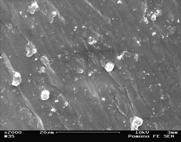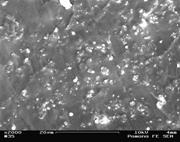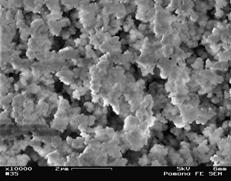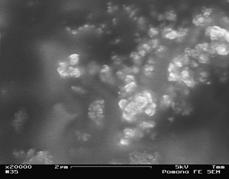
ACS PRF | ACS
All e-Annual Reports

45090-GB5
Tuning Small-Molecule Permeability in Glassy Polymers with Nanoparticles
During the award period, we have made progress in both experimental work and modeling.
Experimental work:
Film preparation
We have developed solution-casting techniques for producing poly(dimethylsiloxane) (PDMS), poly(etherimide) (
Figure 1. SEM images of PDMS with 10 wt% amorphous silica nanoparticles stirred for 72 hours (left; cracks due to sample preparation), 12 hours (middle), and 6 hours (right). We have also initiated a collaboration with Dr. Jeffrey Pyun and Dr. Mary Wirth at the Stöber process particles To examine effects of a wide range of impermeable particle sizes, we have begun synthesizing silica particles using the Stöber process. The particles we obtained were not spherical and were highly agglomerated (see Figure 2); we plan to address this by improving ammonia saturation in the solution and improving temperature control. Figure 2. SEM images of products formed via the Stöber process using 100% butanol (left) and 1:1 methanol:butanol (right) as the solvent. Permeation experiments We have constructed and leak-tested an apparatus for testing single gas permeation through polymer films and developed a MATLAB program for determining the pseudo-steady-state region for data analysis and extracting permeability values. To test the apparatus, we measured the permeability of nitrogen and carbon dioxide in cross-linked PDMS membranes. The values (7.2E-7 cm2/sec and 7.5E-6 cm2/sec, respectively) were reproducible and lower than those in Polymer Handbook for uncross-linked PDMS. We also examined PDMS/SiO2 composite films and found that membranes prepared using longer stir times (which correlate to better nanoparticle dispersion) showed progressively higher permeabilities (permeability increased 25% with a stir time increase from 3 to 72 hours). Positron-Annihilation Lifetime Spectroscopy (PALS) To determine the free volume in polymers and polymer composites (an important indicator of transport properties), we will run PALS on the films. This past summer, we traveled several times to the Modeling: We have begun molecular modeling of polymers using Materials Studio 4.0. We are running molecular dynamics and a series of NVT/NPT equilibration steps to obtain the equilibrium structure of each polymer. We can then simulate gas diffusion and determine free volume in the unit cell. Our goal is to complete molecular modeling of polymer/inorganic nanocomposite and gas transport therein, which to our knowledge has not previously been modeled. Current theories for increased permeability in glassy polymer nanocomposites hinge on interfacial effects and inhibited polymer packing. Therefore, we are particularly interested in the interface between the polymer and the nanoparticle, as well as the difference in polymer configuration due to the presence of nanoparticles. We are currently setting up a computational cluster to drastically decrease the computational time for each run (currently at several months for one pure polymer chain). Research Students: Over the past year, eleven students majoring in biology, chemistry and engineering have participated in the project. The students have been trained on the theory and use of the SEM, learned techniques and developed protocols for solution-casting polymer membranes, synthesized Stöber particles, learned theory and set up a system for PALS, written literature reviews, given technical presentations, attended a conference on plastics, and toured local chemical companies, including Chevron and Amgen. The students are listed below, with their current status given in parentheses: 



